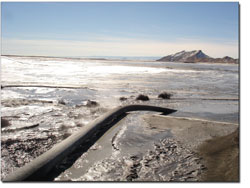|
| ||||
| A struggling San Juan SideStory: Piping into the Reservation: Navajo pipeline forges ahead
by Will Sands
The San Juan flows approximately 400 miles from its headwaters at Wolf Creek Pass through northern New Mexico and Southeast Utah to its union with the Colorado River in Lake Powell. Not only is the San Juan a recreational treasure, it supplies drinking water to tens of millions of people and offers critical habitat to two endangered fish species. However, the canyon country river is officially in distress and carrying a heavy load downstream. “This is a river that’s really in trouble. We’ve had five decades of energy development that have taken a serious toll on the San Juan watershed,” explained attorney Brad Bartlett, of the Energy Minerals Law Center. Bartlett is arguing the suit on behalf of the Center for Biological Diversity, Diné Citizens Against Ruining Our Environment and San Juan Citizens Alliance. Coal mining, combustion at Four Corners Power Plant and the disposal of tens of millions of tons of coal-combustion waste are the culprits, according to the suit. BHP Billiton’s Navajo Coal Mine, located south of Farmington, is a massive 17,000-acre complex that supplies coal to the Four Corners Power Plant. Ten of millions of tons of combustion waste – the by-product of scrubbing the plant’s pollution – have been stored by BHP over the past 40 years. Much of the slurry is stored in gigantic waste ponds at Chaco Wash, just miles from the San Juan. These ponds are believed to be leaching mercury, selenium and other deadly toxins into the river. "Business as usual is over,” said Mike Eisenfeld of the San Juan Citizens Alliance. “There is now overwhelming scientific evidence that regional coal development is driving species in the San Juan River ecosystem toward total collapse."
The news surfaced in a round-about way, when the San Juan River found an accidental ally in the Desert Rock Power Plant, which had been proposed not far from the river. In its analysis of the now-defunct project, the U.S. Fish and Wildlife Service turned up some alarming discoveries. The agency’s draft biological opinion on the plant showed that 64 percent of the endangered Colorado pikeminnow in the San Juan currently exceed mercury contamination thresholds. It went on to reveal that the levels of selenium are impairing growth, reproduction and survival in 40 percent of razorback sucker offspring. These newly hatched fry suffer from developmental anomalies and deformities. The opinion concluded that additional coal development in the San Juan River basin would jeopardize these species’ survival and recovery. “We commend the Fish and Wildlife Service for taking its job seriously,” said Bartlett. “The opinion points to a precipitous decline in the health of the river and these two endangered species. These are far-reaching impacts that point to issues related to the coal complex that have never been addressed.” The suit specifically points the finger at the Department of Interior’s Office of Surface Mining. On Sept. 10 of last year, the office reauthorized the Navajo Mine’s operating permit but did not consult with the Fish and Wildlife Service and failed to comply with the Endangered Species Act. The plaintiffs hope that a victory in the lawsuit will shake up the Four Corners coal complex and clean up both mining and power generation. “After decades of lethal coal pollution, this lawsuit will force the federal government to finally begin treating this beautiful river as something more than an industrial sacrifice zone,” said Taylor McKinnon of the Center of Biological Diversity. The federal government does not comment on pending litigation. •
|



 One of the West’s great rivers is heading dangerously off course. New revelations that the San Juan River is carrying a highly toxic load prompted a lawsuit against the federal government this week. The suit charges that the Department of the Interior has failed to protect the iconic river from the impacts of energy development.
One of the West’s great rivers is heading dangerously off course. New revelations that the San Juan River is carrying a highly toxic load prompted a lawsuit against the federal government this week. The suit charges that the Department of the Interior has failed to protect the iconic river from the impacts of energy development.